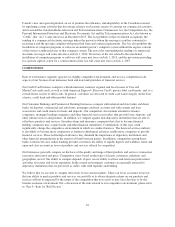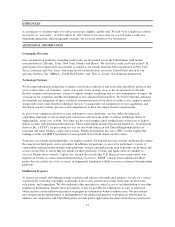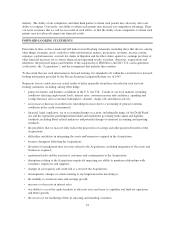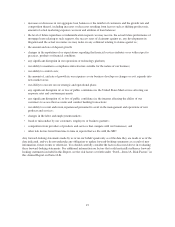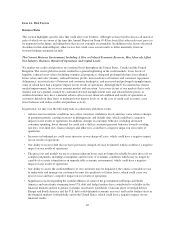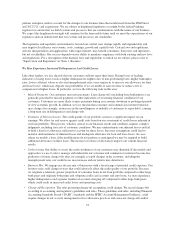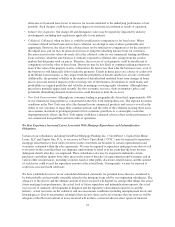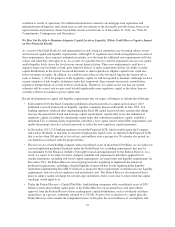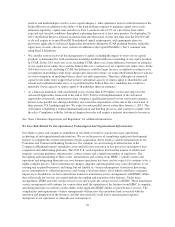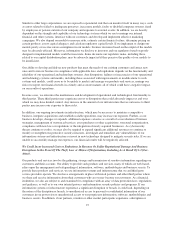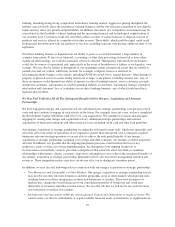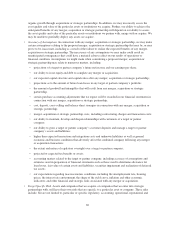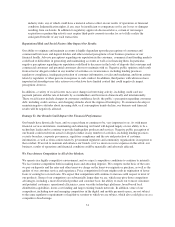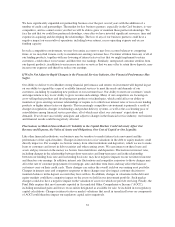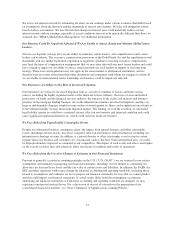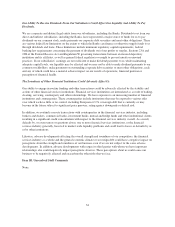Capital One 2013 Annual Report Download - page 44
Download and view the complete annual report
Please find page 44 of the 2013 Capital One annual report below. You can navigate through the pages in the report by either clicking on the pages listed below, or by using the keyword search tool below to find specific information within the annual report.allowance for loan and lease losses to increase for reasons unrelated to the underlying performance of our
portfolio.Such changes could have an adverse impact on our financial condition or results of operation.
•Industry Developments. Our charge-off and delinquency rates may be negatively impacted by industry
developments, including new regulations applicable to our industry.
•Collateral. Collateral, when we have it, could be insufficient to compensate us for loan losses.When
customers default on their loans and we have collateral, we attempt to seize it where permissible and
appropriate.However, the value of the collateral may not be sufficient to compensate us for the amount of
the unpaid loan, and we may be unsuccessful in recovering the remaining balance from our customers.
Decreases in real estate values adversely affect the collateral value for our commercial lending and Home
Loan activities, while the auto business is similarly exposed to collateral risks arising from the auction
markets that determine used car prices. Therefore, the recovery of such property could be insufficient to
compensate us for the value of these loans. Borrowers may be less likely to continue making payments on
loans if the value of the property used as collateral for the loan is less than what the borrower owes, even if
the borrower is still financially able to make the payments. Trends in home prices are a driver of credit costs
in the Home Loans business as they impact both the probability of default and the loss severity of defaults.
Additionally, the potential volatility in the number of defaulted and modified loans from changes in home
prices can create material impacts on the servicing costs of the business, fluctuations in credit marks and
profitability in acquired portfolios and volatility in mortgage servicing rights valuations. Although home
prices have generally appreciated recently, the slow economic recovery, shifts in monetary policy and
potentially diminishing demands from investors could threaten or limit the recovery.
•New York Concentration. Although our consumer lending is geographically diversified, approximately 40%
of our commercial loan portfolio is concentrated in the New York metropolitan area. The regional economic
conditions in the New York area affect the demand for our commercial products and services as well as the
ability of our customers to repay their commercial loans and the value of the collateral securing these loans.
An economic downturn or prolonged period of slow economic growth in, or a catastrophic event that
disproportionately affects, the New York region could have a material adverse effect on the performance of
our commercial loan portfolio and our results of operations.
We May Experience Increased Losses Associated With Mortgage Repurchases and Indemnification
Obligations.
Certain of our subsidiaries, including GreenPoint Mortgage Funding, Inc. (“GreenPoint”), Capital One Home
Loans, LLC and Capital One, N.A., as successor to Chevy Chase Bank (“CCB”), may be required to repurchase
mortgage loans that have been sold to investors in the event there are breaches of certain representations and
warranties contained within the sales agreements. We may be required to repurchase mortgage loans that we sell
to investors in the event that there was improper underwriting or fraud or in the event that the loans become
delinquent shortly after they are originated. These subsidiaries also may be required to indemnify certain
purchasers and others against losses they incur in the event of breaches of representations and warranties and in
various other circumstances, including securities fraud or other public disclosure-related claims, and the amount
of such losses could exceed the repurchase amount of the related loans. Consequently, we may be exposed to
credit risk associated with sold loans.
We have established reserves in our consolidated financial statements for potential losses that are considered to
be both probable and reasonably estimable related to the mortgage loans sold by our originating subsidiaries. The
adequacy of the reserve and the ultimate amount of losses incurred will depend on, among other things, the actual
future mortgage loan performance, the actual level of future repurchase and indemnification requests, the actual
success rate of claimants, developments in litigation and the regulatory environment related to us and the
industry, actual recoveries on the collateral, and macroeconomic conditions (including unemployment levels and
housing prices). Due to uncertainties relating to these factors, there can be no assurance that our reserves will be
adequate or that the total amount of losses incurred will not have a material adverse effect upon our financial
24




